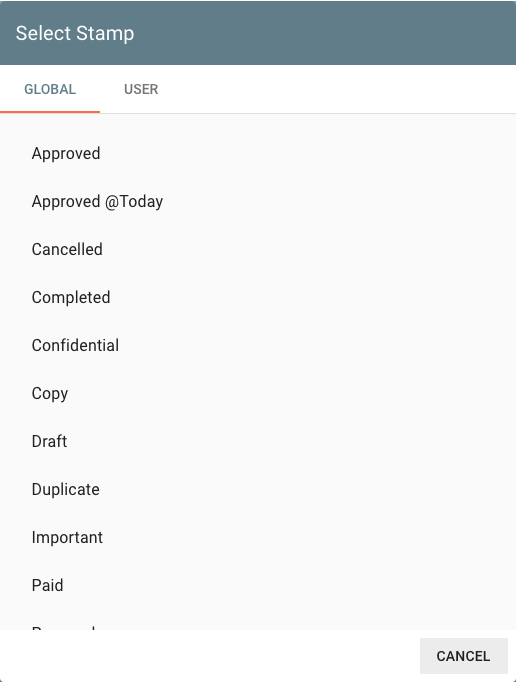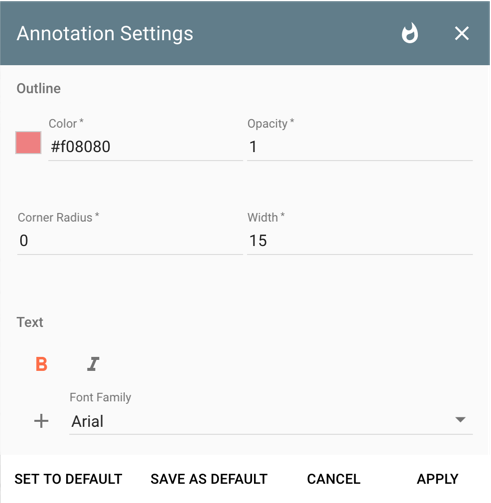Annotate Documents
Annotations allow you to easily markup documents, or redact sensitive data while protecting the integrity of the original record. Documents can be annotated using the tools found in the Annotate menu of the Document Viewer.
Annotations layer in the order they are created. For example, if you create a Note, then draw a highlight, if the two overlap, the highlight will appear in front of the Note. You may customize your annotations including custom stamp creation, and color of a Note along with its font type, color and border, and set styles, if you wish. You can add annotations to any file format, but if you send out an email with annotations, the file will be convert to the PDF file format.
Annotations May be Burned In
If you are working in an Archive where you do not have Modify Annotations permission, moving a document with annotations will cause any annotations to become a permanent part of the document. This means the annotations are embedded, and the document is now a new PDF. This is a permanent change, so care should be taken when secure archives with this type of process flow.
Create Annotations
To create an annotation in the Document Viewer, in the Annotation menu, click one of the Annotation buttons.
- To highlight a portion of the document page, click Highlight and then drag to select the area.
- To add a stamped message, click Stamp and in Select a Stamp, choose a stamp. The GlobalSearch administrator can create system wide stamps, or users may create their own by clicking on the USER tab.
To black out an area of a page from general view, click Redact and then use your mouse to drag around the area to be redacted.
Redact Documents with Care
Any Annotation, including redaction, which is not burned into a PDF file can be changed by anyone with Annotation permissions to the document, so it may not be effective for blocking access to document information internally. For situations such as sensitive HR or medical records, a good solution might be to restrict access to original documents and make available only those PDF files which are correctly and permanently redacted.
For security, KeyFree Indexing will not do an OCR scan under a redaction created if the you do not have Modify Annotations permission for the document’s Archive.
Tip: Edit with “White Out.” Set the redaction color to white (or whichever color the document background is) to “erase” parts of a document. Also, if a redaction covers a large area of the page, when printing, selecting white instead of black saves on toner. Use this with care, as some industries have specific regulations regarding redaction colors.
- To add a Note, click Note and then drag to create the Note area. When positioned, enter your text.
- Image annotations can be added to embed a local image into a document. This is often employed by users looking to embed an image of their signature that is stored locally on the computer, or in other cases where an image or photo needs to be added to the document and adding a new document page isn't practical or necessary (insurance claims for example).
- Clicking the Image annotation will prompt the user to select or upload a new image. Images are only kept for the duration of the current viewer session. If a user were to select multiple documents, they would be able to apply the same image to multiple documents or pages without uploading it more than once, but only while the current viewer is open.
- Click the Upload button to select a new local image file. The Image annotation type supports files with extensions: "jpg", "jpeg", "bmp", "png", "gif", "tif", "tiff".
- Once uploaded, click the image.
Using the mouse, click and drag a box on the page where the image should be placed.
Color Images
Attaching images that are color have the potential to drastically impact a file's size. Use caution when embedding image annotations to prevent performance issues related to transmitting large files.
- Clicking the Image annotation will prompt the user to select or upload a new image. Images are only kept for the duration of the current viewer session. If a user were to select multiple documents, they would be able to apply the same image to multiple documents or pages without uploading it more than once, but only while the current viewer is open.
- You can electronically sign a document or create a freehand notation into PDF image file or TIF document. This is a “live” or “wet” signature. When the document is saved, marks made with the Sign feature become a permanent part of the document.
- Click Signature menu option. This menu pulls right, offering the user an option to freehand draw a signature or select an image annotation for signing.
- If using the freehand option, use the mouse to draw a box around the area where the signature should be drawn.
- In the Please Sign Below window, use the mouse pointer to draw a signature.
- Click Sign to add the signature or click Clear to erase the signature and try again.
If using the Image signature, use the instructions from point 5 above.
- Click Signature menu option. This menu pulls right, offering the user an option to freehand draw a signature or select an image annotation for signing.
- Several "drawing" annotations are available for more ad-hoc annotation needs. Click the Draw button from the Annotations menu and available options will open in the sub-menu.
Options include Freehand, Ellipse, Line, and Lines.
Edit Annotations
To edit an Annotation, select the Annotation, and then make one or more of the following changes:
- Move – Select the Annotation. When selected, an annotation will show "handles" around its outside edge. Click and drag it to another position on the document page.
- Change Size or Shape – Select the Annotation and drag the sizing handles around the area.
- Edit Properties – To change the style properties of an Annotation, right-click on it and click Properties.
Not all annotations will support all properties, but in general, fill and outline colors, as well as sizes are configurable for annotations. All Annotation Settings windows include a set of buttons to perform basic tasks:- Apply - Save the annotation changes to the currently selected annotation.
- Cancel - Abandon any settings changes made to the current annotation.
- Save As Default - Save the current settings as the default settings for all annotations of this type going forward. If for example a user wanted their redaction color to be white for all redactions, the would simply draw a redaction and edit the properties. Once setting the correct Fill color, clicking Save As Default would make all new annotations match the current settings. Note, this only impacts settings for the current user. Users have individual control over their defaults.
- Set To Default - Clicking this will reset any non-default settings back to the currently saved defaults.
Replicate Annotations
Draw a new annotation, using the settings of the selected annotation. This option allows you to copy annotations settings, even when they are not the default for that annotation type.
Delete Annotations
To delete an Annotation from a document, right-click on it and select Delete. Once saved, any mark's made with the Sign option are permanent and can not be deleted.






